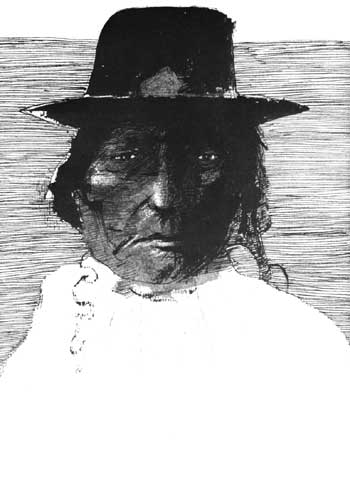|
LITTLE BIGHORN BATTLEFIELD National Monument |
 |
THE ART AND THE ARTIST
Leonard Baskin, sculptor, draftsman, printer, and printmaker, is the latest in a seemingly infinite series of artists who have portrayed the events of June 25, 1876. The decision to commission the drawings reproduced in this handbook is a most proper service to the memory of the Battle of the Little Bighorn. Baskin cuts through a century of mediocre, apocryphal pictures to reveal the actors of this tragic drama as they were, not in the event, but in life and in death.
In 1968 an effort was made by the staff of the Amon Carter Museum in Fort Worth to catalogue the many pictures of the Custer fight. With more than 900 versions identified, it is an established fact that this sad occasion is the most memorialized single event in American history. A deluge of paintings, prints, sculptures, cigarette cards, bottle caps, whiskey labels not to mention murals—have been inspired by the battle. Each, of course, is the product of the artist's imagination. Many have been copied even three and four times, while others are sincere efforts at historical reconstruction of the event based upon documents, eye-witness accounts, and physical remains.
In a situation where imagination may properly replace truth (no witness survived to contest the artist), it is curious that almost every artist to the present time has been absorbed in the reality of the event and has neglected the human overtones—the sullen quiet of the Indian betrayed the sudden surprise and totality of death on the vast plains—the frustration of hindsight judgments—the responsibilities and loyalties obliterated in the aftermath. There were no victors that day; just survivors, each aware that a day of reckoning had passed and another would soon be upon them. As in any disaster, many people learn much, but too late.
If this foreboding air hangs over Baskin's drawings to leave the reader disquieted, it is because the artist has sensed the real tragedy of Custer and the Indians. Authority and manifest destiny had in some way contradicted our "solemn word" and treaty obligations. Custer and his men became the instruments to correct a situation embarrassing both in Washington and on the frontier—a change of mind. Examine Baskin's drawings—Indians and officers; all are asking "Why?"
We see man's mortality, brutality, and futility. And yet we read in the faces of Baskin's people the basic humanity which ties us together in a tragic climax no one seems to comprehend. Leonard Baskin teaches art at Smith College, Northampton, Mass. His work is represented in collections of the major art museums of the United States by examples of sculpture, drawings, prints, and fine press books. His genius, combined with a great sense of design and typography, is reflected in the publications of the Gehenna Press, founded by Baskin in 1942 and now located at Northampton.
Mitchell A. Wilder November 1968


|
|
Last Modified: Sat, Sep 28 2002 10:00:00 pm PDT |


